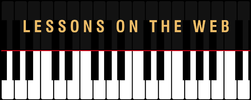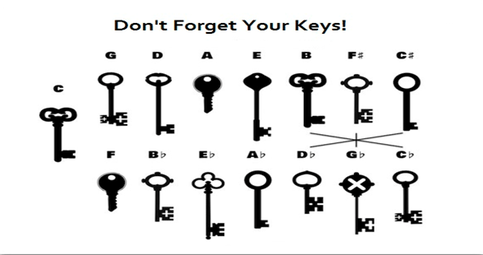|
Don’t forget your keys! One of the first things you’ll learn in music theory is what a key signature is and all the different keys that music can be played in. The key signature essentially tells you what notes to play or not to play in a particular piece. There are 24 total different keys in music, composed of 12 major keys and 12 minor keys. These keys contain either sharps or flats; unless you’re playing in the key of C, which has no sharps or flats. Sharps, flats and natural symbols are usually indicated in the key signature section of the staff or by a sharp or flat sign before the actual note. Sharps and flats are always added in a specific order. Sharps are listed in this order: F, C, G, D, A, E, B, and the Flats are always listed in the reverse order: B, E, A, D, G, C, F. To determine which note is sharp or flat on the staff, look at the center of the symbol and whatever note is in the very center, is the note that you will play sharp or flat. Take for example the key of G: the center of the sharp symbol is on the top line of the staff, which is the note F, so you will play all F#’s in that piece. A sharp or flat identified in the key signature shows you that every time you play that note, it is either sharp or flat. For example, when a piece is in the key of G, you play every F sharp — whether you play it with your right hand or left hand and wherever it is on the keyboard. To figure out which major key you're in, look at the last sharp in the key signature. If it's on a line, go up to the next step and if it's a space, go up to the next line; and that's what key you're in. For example, if you have three sharps — F#, C#, and G#, look to the last sharp, G#. If you go up to the next note, you find what key you're in: A major. To figure out what flat key you’re in, look at the next-to-last flat in the key signature and that is the name of the key you're playing in. For example, if you have four flats, Bb, Eb, Ab, and Db, look at the next-to-last flat: you're in Ab major. The easiest flat key to remember is F, as it only has one flat, which is Bb. There are both major and minor keys that share the same key signature and it’s not always easy to know which mode the piece is in. For example, C major and A minor both have the same key signature, which is no sharps and no flats. To figure out which mode your piece is in, look at the first chord of the piece. If the bottom note of the first chord is a C, odds are the piece is in C major. Alternatively, if that bottom note is A, the key is probably A minor. Once you understand what a key signature is, learn the different keys, and know how to determine whether a piece is in a major or and minor key, you’ll be able to start learning pieces much easier and even write one or two yourself! ___________________________________________________________________________ You can learn more about key signatures by watching my free video “What is a Key and Key Signature” on my YouTube piano lesson page! Stay Connected to LessonsOnTheWeb and Learn Much More!
LessonsOnTheWeb Academy: High Quality Music Classes LessonsOnTheWeb Official Twitter: @LessonsOnTheWeb LessonsOnTheWeb Official Facebook: Free Videos, and Offers Leave a Reply. |
AuthorMost blogs written by Archives
June 2020
Categories
All
|


 RSS Feed
RSS Feed